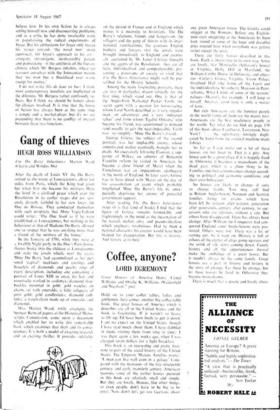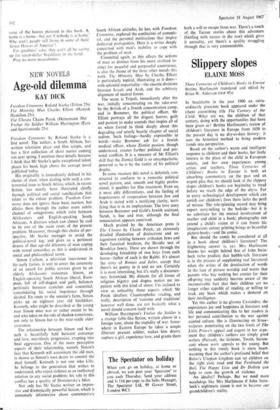Coffee, anyone?
LORD EGREMONT
(mem Douses of America Henry Lionel Williams and Ottalic K. Williams (Weidenfeld and Nicolson 7 gns) Hold on to your coffee tables, ladies and gentlemen, here comes another big coffee-table book. The great houses of America which it describes are all in the United States, and the hook is fascinating. If it weren't so heavy to lift up. I'd have been loath to put it down. I am no expert on the United States, though I have read much about them. I have dabbled in them, visiting them from time to time: I was there again a few weeks ago, when I was charged seven dollars for a light breakfast.
This book is an interesting and pretty foot- note to part of the social history of the United States. The Emperor Marcus Aurelius wrote: 'A man can live well even in a palace.' Com- pared with the mansions of the late nineteenth century and early twentieth century American tycoons, some of the earlier houses pictured in this book are relatively small and simple. But they arc lovely. Houses, like other things, or even people. don't have -to be big to be great. Now don't let's get too facetious about any great American house. The Greeks could snigger at the Romans. Before any English- men start sniggering at the Americans let them look round at some of the huge and dreadful piles erected here when everybody was getting richer except the poor.
There are thirty houses described in this book. Each is interesting in its own way. Some are lovely. like Monticello (Jefferson's house) in Virginia. Holly !till in Maryland, the William (orbit !louse in Delaware, and others too—Carter's Grove. Virginia. Tryon Palace. Stratford Hall (the home ‘of the Lees) and the individualistic Strawberry Mansion in Penn- sylvania. What I think of some of the tycoons' palaces—Hearst's. for example- I will keep to myself. Anyway. good taste is only a matter of taste.
But rich .Nmericans are the funniest people in the world (sonic of them are the nicest, tool. Americans are the best machinery people in the world. Yet what do we find on page 138 of this book about I a ndhurst. Tarrytown, New York? '. . . the upholstery ---lovingly dupli- cated by hand from the original machine-made fabrics . .
So far as I can make out a lot of these houses are not lived in. That is a pity. Any house can he a good place if it is happily lived in. Otherwise it becomes a mausoleum of the dead past. which is a glum thing to be. Families and their circumstances change accord- ing to political and economic conditions and their own behaviour.
So houses are likely to change—if only to change hands. You may still find in Britain Anglo-Saxon. Norman and Scottish families living on estates which have been left by testator aftet testator. generation after generation. century after century, to suc- cessors who are relatives, without a sale. But others have disappeared..) here has always been change. After William the Conqueror had con- quered England some Anglo-Saxons were pro- moted. Others were not. There was a lot of sorting out. So it went on. History is full of echoes of the clatter of clogs going upstairs and the swish of silk skirts coming down. Family history and all the appurtenances thereof make the ambience of a great house. But it needn't always he the same family. Great houses are a part of history and history is the story of change. I et there be change, but let these houses be lived in. Otherwise they become mausoleums.
. There is much that is poetic and lovely about
some of the houses pictured in this book. A home is a hOme—butnot if nobody is at home:* Why aren't people still living in some of thei'& 'Great Houses of America'?
For goodness' sake, they can't all be saving up for seven-dollar breakfasts in the hotel. Pray no more mausoleums.































 Previous page
Previous page